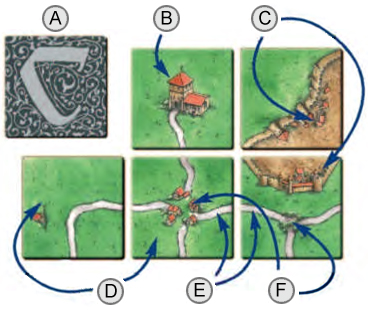Base game (1st edition)
General info and comments
originally released by Hans im Glück in 2000
A clever tile-laying game for 2 to 6 players aged 8 and above by Klaus-Jürgen Wrede
The city of Carcassonne in southern France is famous for its unique Roman and Medieval fortifications. The players take their chances with their followers in the cities, cloisters, farms and on the roads around Carcassonne. The development of the land is in their hands, and the skillful deployment of the followers as thieves, knights, monks and farmers is the path to success.
Contents
- 72 land tiles (including one with a dark reverse) which depict road, city and field segments, as well as cloisters and crossings.[1]
Each follower can be deployed as a knight, monk, thief or farmer. One follower of each color is used as a scoring marker.
- One scoreboard. This is used to track players' scores
- One rule booklet and one supplement.
Rules
Overview
The players place the land tiles turn by turn. This leads to the growth of roads, cities, cloisters and farms, to which the players may deploy their followers in order to earn points. As points can be won during the game as well as at the end, the winner will only emerge during the final scoring.
Preparation
The starting tile is placed in the middle of the table.[4] The remaining tiles are mixed and placed face-down on the table in several stacks, so that each player can access them easily.[5] The scoreboard should be placed at the edge of the table if possible.
Each player chooses a color and receives the eight followers, placing one on the ‘0’ field of the scoreboard as a scoring marker. The remaining seven followers stay with the player for the moment, as his or her supply.
The youngest player decides who starts the game.[6]
Playing the game
Play progresses in a clockwise fashion. The player whose turn it is carries out the following actions in the order given:
- The player must draw one new land tile and place it.
- The player may draw one follower from his or her supply and deploy it to the tile just placed.
- If any roads, cities, or cloisters are completed through the placement of the tile, they must be scored now.
Then it is the next player's turn.
1. Place a tile
As their first action, the player must draw a tile from one of the stacks. The tile is then shown to the other players (so they can ‘advise’ the player about where to place it) and placed on the table. The player must take care to observe the following points:
- At least one side of the new tile (with a red border in the examples below) must touch one or more tiles already in play.[7] Corner-to-corner placement is not permitted.
Use of a Table
Lorem ipsum
Footnotes
For Icons explanation and licensing please visit Icons page.
- ↑
 The RGG edition of the Big Box 1, which includes The River, adds the following sentence here:
“The 12 river tiles are NOT part of the basic game but do have the same back as the starting tile.”
The RGG edition of the Big Box 1, which includes The River, adds the following sentence here:
“The 12 river tiles are NOT part of the basic game but do have the same back as the starting tile.”
- ↑
 Question: Too few followers—are we playing wrong or are there really too few? Answer: In our view there are not too few. A certain shortage of followers is entirely intentional. An important element of the game is precisely learning to be economical with one's followers.
Question: Too few followers—are we playing wrong or are there really too few? Answer: In our view there are not too few. A certain shortage of followers is entirely intentional. An important element of the game is precisely learning to be economical with one's followers.
- ↑
 As far as the Big Box is concerned, the sixth set of (gray) followers is a part of the basic game, not Inns and Cathedrals. Additionally, Big Box 5 adds purple and pink followers for up to 8 players.
As far as the Big Box is concerned, the sixth set of (gray) followers is a part of the basic game, not Inns and Cathedrals. Additionally, Big Box 5 adds purple and pink followers for up to 8 players.
- ↑
 See notes on Use of a Table (5/2013)
See notes on Use of a Table (5/2013)
- ↑ File:Icon House Blue.png Tiles can also be placed into a sack and drawn randomly.
- ↑
 This paragraph represents the current HiG rules. The RGG rules state that the players decide among themselves who will be the starting player, and the ZMG rules mention both options.
This paragraph represents the current HiG rules. The RGG rules state that the players decide among themselves who will be the starting player, and the ZMG rules mention both options.
- ↑
 Question: We have difficulty deciding when a placed tile represents a new city or belongs to one already being built. Answer: 'Corner to corner' is not a connection! Segments can only be connected on the edges. In the example shown there are two cities at the moment.
Question: We have difficulty deciding when a placed tile represents a new city or belongs to one already being built. Answer: 'Corner to corner' is not a connection! Segments can only be connected on the edges. In the example shown there are two cities at the moment.



